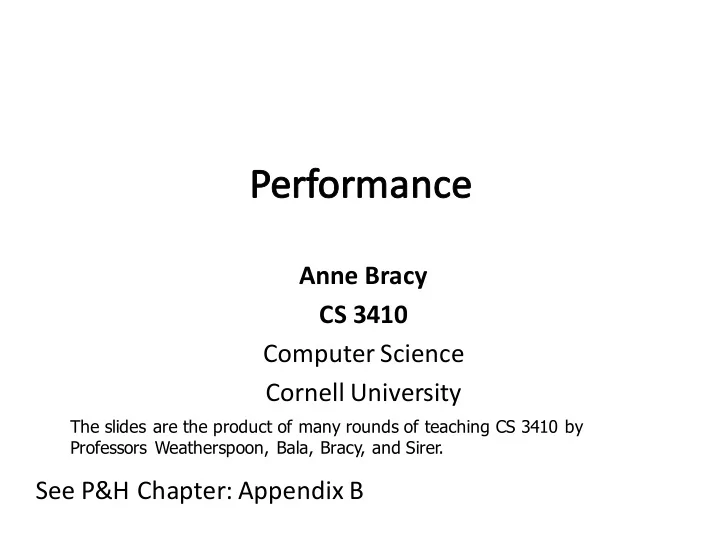

Anne Bracy CS 3410 Computer Science Cornell University The slides are the product of many rounds of teaching CS 3410 by Professors Weatherspoon, Bala, Bracy, and Sirer. See P&H Chapter: Appendix B
Complex question • How fast is the processor? • How fast your application runs? • How quickly does it respond to you? • How fast can you process a big batch of jobs? • How much power does your machine use? 2
Latency (execution time) : time to finish a fixed task Throughput (bandwidth) : # of tasks in fixed time • Different: exploit parallelism for throughput, not latency (e.g., bread) • Often contradictory (latency vs. throughput) – Will see many examples of this • Use definition of performance that matches your goals – Scientific program: latency; web server: throughput? 3
Car: speed = 60 miles/hour, capacity = 5 Bus: speed = 20 miles/hour, capacity = 60 Task: transport passengers 10 miles Latency (min) Throughput (PPH) Car Bus 4
+ 4 Register I$ PC File D$ s1 s2 d Single-cycle datapath : true “atomic” fetch/execute loop Fetch, decode, execute one instruction/cycle + Low CPI (see later slides): 1 by definition – Long clock period: to accommodate slowest instruction (PC à I$ à RF à ALU à D$ à RF) 6
+ 4 A Register I$ PC O D File B D$ s1 s2 d Multi-cycle datapath : attacks slow clock Fetch, decode, execute one insn over multiple cycles Allows insns to take different number of cycles (main point) ±Opposite of single-cycle: short clock period, high CPI 7
Single-cycle • Clock period = 50ns, CPI = 1 • Performance = 50ns/insn Multi-cycle: opposite performance split + Shorter clock period – Higher CPI Example • branch: 20% ( 3 cycles), load: 20% ( 5 cycles), ALU: 60% ( 4 cycle) • Clock period = 11ns , CPI = (20%*3)+(20%*5)+(60%*4) = 4 – Why is clock period 11ns and not 10ns? • Performance = 44ns/insn Aside: CISC makes perfect sense in multi-cycle datapath 8
Program runtime: seconds instructions cycles seconds x x = program program instruction cycle Instructions per program : “dynamic instruction count” • Runtime count of instructions executed by the program • Determined by program, compiler, ISA Cycles per instruction : “CPI” (typical range: 2 to 0.5) • How many cycles does an instruction take to execute? • Determined by program, compiler, ISA, micro-architecture Seconds per cycle : clock period, length of each cycle • Inverse metric: cycles/second (Hertz) or cycles/ns (Ghz) • Determined by micro-architecture, technology parameters For lower latency (=better performance) minimize all three • Difficult: often pull against one another 9
CPI : Cycle/instruction for on average • IPC = 1/CPI – Used more frequently than CPI – Favored because “bigger is better”, but harder to compute with • Different instructions have different cycle costs – E.g., “add” typically takes 1 cycle, “divide” takes >10 cycles • Depends on relative instruction frequencies CPI example • Program has equal ratio: integer, memory, floating point • Cycles per insn type: integer = 1, memory = 2, FP = 3 • What is the CPI? (33% * 1) + (33% * 2) + (33% * 3) = 2 • Caveat : this sort of calculation ignores many effects – Back-of-the-envelope arguments only 10
Assume a processor with instruction frequencies and costs • Integer ALU: 50%, 1 cycle • Load: 20%, 5 cycle • Store: 10%, 1 cycle • Branch: 20%, 2 cycle Which change would improve performance more? A: “Branch prediction” to reduce branch cost to 1 cycle? B: “Cache” to reduce load cost to 3 cycles? Compute CPI INT LD ST BR CPI Base A B 11
1 Hertz = 1 cycle/second 1 Ghz = 1 cycle/nanosecond, 1 Ghz = 1000 Mhz General public (mostly) ignores CPI • Equates clock frequency with performance! Which processor would you buy? • Processor A: CPI = 2, clock = 5 GHz • Processor B: CPI = 1, clock = 3 GHz • Probably A, but B is faster (assuming same ISA/compiler) Classic example • 800 MHz PentiumIII faster than 1 GHz Pentium4! • Example: Core i7 faster clock-per-clock than Core 2 • Same ISA and compiler! Meta-point: danger of partial performance metrics! 13
(Micro) architects often ignore dynamic instruction count • Typically have one ISA, one compiler → treat it as fixed CPU performance equation becomes Latency: seconds cycles seconds = x insn insn cycle Throughput: insn insn cycles x = seconds cycles second MIPS (millions of instructions per second) • Cycles / second : clock frequency (in MHz) • Ex: CPI = 2, clock = 500 MHz → 0.5 * 500 MHz = 250 MIPS Pitfall: may vary inversely with actual performance – Compiler removes insns, program faster, but lower MIPS – Work per instruction varies (multiply vs. add, FP vs. integer) 14
Decrease latency Critical Path • Longest path determining the minimum time needed for an operation • Determines minimum length of clock cycle i.e. determines maximum clock frequency expected outputs inputs arrive combinatorial Logic t combinatorial 15
Goal: Make Multi-Cycle @ 30 MHz CPU (15MIPS) run 2x faster by making arithmetic instructions faster Instruction mix (for P): • 25% load/store, CPI = 3 • 60% arithmetic, CPI = 2 • 15% branches, CPI = 1 What is CPI? Goal: Make processor run 2x faster (30 à 15 MIPS) Try: Arithmetic 2 à 1? (2 à X what would x have to be?) 16
Amdahl’s Law Execution time after improvement = execution time affected by improvement + execution time unaffected amount of improvement Or: Speedup is limited by popularity of improved feature Corollary: build a balanced system • Don’t optimize 1% to the detriment of other 99% • Don’t over-engineer capabilities that cannot be utilized Caveat: Law of diminishing returns 18
Recommend
More recommend